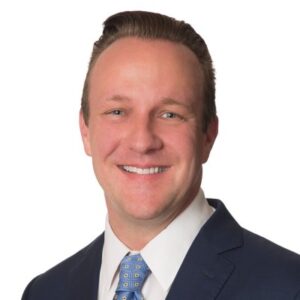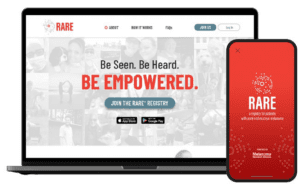Rare Community Profiles

Rare Community Profiles is a Patient Worthy article series of long-form interviews featuring various stakeholders in the rare disease community, such as patients, their families, advocates, scientists, and more.
Melanoma Research Alliance’s Marc Hurlbert Shares Milestone Achievement of RARE Registry for Acral and Mucosal Melanoma
Patient registries can be incredibly important in rare disease and cancer research. Through these registries, affected individuals can share their personal experiences, track their progression, find potential matches for clinical trials, and even have their data leveraged to advance research.
In 2020, the Melanoma Research Alliance (MRA) launched the industry-leading RARE Registry for people with acral or mucosal melanoma. As patients continuously provide details such as diagnosis, treatment, and demographics, researchers and clinicians gain key insights into tumor genomics, risk factors, quality-of-life preservation, and more.
Recently, the RARE Registry hit a milestone when it officially surpassed 135 patients, making it the largest registry of its kind in the world. Marc Hulbert, CEO of the MRA, shared with Patient Worthy more about this milestone, myths about melanoma that we need to address, and the need for continued awareness.
JL: Please tell me a little bit more about yourself.
MH: As the CEO of the Melanoma Research Alliance, I oversee the strategic direction for the largest nonprofit funder of melanoma research in the world. I am responsible for setting and executing the strategic direction of the organization and its science programs.

I am a pharmacologist by training and previously served as the MRA’s Chief Science Officer. I have over 20 years of patient advocacy and grant-making experience. Throughout my career in nonprofits, I’m proud to have administered over $750M in support to over 3,200 biomedical research grant organizations. Before joining MRA, my nonprofit work included leading the expansion of public health programs to enable low-income, uninsured, and minority patient populations diagnosed with cancer to access treatments and care across the United States, and in developing countries around the world.
Please tell me about the Melanoma Research Alliance.
Founded in 2007 by Debra and Leon Black, the Melanoma Research Alliance has a mission of ending suffering and death due to melanoma by advancing the world’s most promising science and research. MRA provides critical funding for melanoma cancer research that propels advances in prevention, diagnosis, treatment, metastasis, and survivorship.
Over the years, MRA has committed over $150 million and leveraged an additional $417 million from outside sources to fund life-saving melanoma research. The outstanding science happening in the melanoma field drew me to MRA. Melanoma research is leading the way—and MRA-funded researchers have been behind every major melanoma research breakthrough. Since MRA’s inception, more than 16 new treatments for melanoma have earned FDA approval.
Melanoma research has opened, and is still opening, doors in other areas. For example, two classes of medications—targeted and immune-based therapies—were pioneered in melanoma. Today, that energy and moment is driving all of oncology forward. It’s a very exciting time, and I’m glad to be part of it.
What is the RARE Registry, and why did the MRA develop it?
The RARE Registry is a direct-to-patient bidirectional interactive portal for patients with acral and mucosal melanomas. MRA launched the RARE Registry because research into rare melanomas was not keeping up with advances that we were seeing for cutaneous melanoma, the most common type of melanoma.
While the last decade has seen positive advances in treatments for cutaneous melanomas, patients with rare melanoma subtypes continue to have a far worse 5-year survival rate. We wanted to disrupt this status quo because we believe that nobody should be left behind. So the MRA launched the RARE Registry to bridge this divide and meet the unmet needs of the community of patients with acral or mucosal melanoma. Created for and with patients, the RARE Registry creates a centralized resource platform for patients, caregivers, researchers, and physicians.
Before we move on, can you explain what acral and mucosal melanoma are?
Roughly 90% of melanomas are cutaneous and form on sun-exposed skin. Rare melanoma subtypes like acral and mucosal form in parts of the body that are shielded from the sun, such as the palms of the hands, soles of the feet, under fingernails, and inside nasal or oral cavities. In particular, acral melanoma forms on the palms, soles, and/or underneath nails. Mucosal melanoma forms in the nasal cavities and mucosal linings of other tissues.
Each year, about 3,000 to 5,000 patients are diagnosed with these subtypes. About 2,000 cases of acral melanoma are diagnosed each year, representing 2-3% of melanoma cases in the United States, with around 1,000 cases of mucosal melanoma diagnosed each year, representing 1% of cases in the United States. Due to their relative obscurity, patients facing these rare subtypes are often diagnosed later and have poorer prognoses.
How does participating in the RARE Registry empower patients?
Acral and mucosal melanomas are both rare, so each participant is crucial. Researchers, clinicians, and companies need to better understand who is affected and how they are affected in order to successfully develop effective treatments and to identify potential causes of these rare melanomas. By voluntarily sharing information through the RARE Registry, patients can feel confident that the field is focused on aspects of the disease that are most important to those affected. RARE also enables patients to engage with one another as well as the research community in new ways. Doing so will provide a more comprehensive picture of patients facing these rare melanoma subtypes as well as what many patients crave most: community connection.
What are some of the features of the RARE Registry?
We hope that the RARE Registry will serve a critical role in helping us answer some of the many questions about these rare subtypes, such as what causes them, what are the best treatment options, and what obstacles patients experience in getting an appropriate diagnosis. We are also focusing heavily on quality-of-life. This is such an important factor, but often neglected in studies.

How does the RARE Registry contribute to research advancement? What insights can be gleaned from the registry?
Through the RARE web portal, patients provide information on their demographics, diagnosis, treatment history, lifestyle, and quality-of-life factors. In turn, the RARE Registry contributes to research advancement by investigating critical questions about risk factors, genetics, epidemiology, diagnosis pathways, treatment effectiveness, adverse events, natural history of disease, clinical trial awareness and quality of life for patients with acral and mucosal melanoma.
Through the registry, we also want to get a better understanding who gets these melanomas and when. Each participant represents a single piece of the puzzle. Taken one at a time, we can’t see patterns. But when you get a bunch of pieces and put them together – like in a registry – you can see a fuller picture and begin to understand patterns. That’s what we are trying to do. We also want to understand more about both inherited genetics—the genes you inherit from your biological parents—and the genomics of these rare tumors, meaning the specific mutations the tumor contains.
In a patient registry like RARE, we may be able to learn if there are any genetic risk factors for those rare melanoma types, something we can only do when looking at hundreds or thousands of patients. We can also look at the tumor characteristics on a bigger scale. Previous studies, some funded by MRA, have helped identify some novel tumor mutations in acral and mucosal melanoma. But, again, looking at a larger sample of patient samples, we may be able to still identify new treatment targets in the tumor mutations.
For example, in cutaneous melanoma, about half of patients have what is called a BRAF mutation. As a result, researchers worked to develop treatments that specifically shutdown that mutation and ultimately slow the growth of the tumor. We don’t have any equivalent for mutations frequently found in these rare tumors.
Outside of the Registry, MRA does a wonderful job of educating people about melanoma and overcoming existing myths or misconceptions. What misconceptions do you feel are most important to address?
One of the biggest misconceptions about melanoma is how prevalent it actually is. Many people, including people of color or people who don’t think they spend much time in the sun, believe that they aren’t at risk for melanoma. This leads to delayed detection and treatment. Anyone can get melanoma!
Everyone should know their bodies (what spots, moles, marks you have) and check their skin for anything new or changing – and if you notice something changing, get it checked out by your doctor. The other misconception, which we’re working hard to combat through our work with RARE, is that melanoma is only caused by sun or UV exposure. As we’ve mentioned, these rare melanoma subtypes can form on places like the bottom of the foot where there’s little to no sun exposure whatsoever.
Lastly, a big misconception is that sunscreen is only needed during the summer or trips to a sunny destination. UV exposure is dangerous year-round and sun protection should be used in all seasons.
As you know, people of color have a higher risk for rare melanoma. But rare melanomas are also underdiagnosed in people of color. How can we transform the diagnostic and treatment landscape to improve equity?
First and foremost, we want everyone to understand that melanoma can happen to anyone. We all don’t have the same risk – but we do all have some risk even if it’s low risk. So, everyone should get to know their skin, check themselves out, and bring any new or changing lesions or moles to the attention of your doctor.
Second, providers also need to be educated about all melanoma subtypes – including how it presents in people of color – so that they take patients’ concern seriously.
Finally, I think we need to find new models to bring dermatology care to rural America and other places where access to a dermatologist is low. Technology such as artificial intelligence, which MRA is investing in heavily, may be part of that answer.
What are some of the latest clinical breakthroughs in melanoma research? In your opinion, what are the most impactful breakthroughs recently?
Treatment options for melanoma have dramatically expanded in the past decade. We went from 2 FDA approved treatments in 2007 to 19 today. This progress has been fueled by advances in molecularly targeted therapies and by the discovery of checkpoint immunotherapies that can take the brakes off the immune system, allowing it to home in on and attack cells. Exciting recent and ongoing clinical research has expanded the number of immunotherapy targets (we now have drugs that target CTLA4, PD1, LAG3 and TCR); and ongoing studies looking at possible combinations of these drugs as well as looking at cell-based immunotherapies.
Ideally, what kind of research would you like to see in the future?
At MRA, we’d like expanded research focus on a few different patient populations, including patients with treatment-resistant melanomas; patients with brain metastases and/or leptomeningeal disease (melanoma that has infiltrated the cerebrospinal fluid and membranes that surround the spine); and patients with rare melanomas.
I also hope that we can contribute to new approaches to melanoma prevention and early detection by expanding our prevention toolbox when it comes to melanoma and other skin cancers. Similarly, we’d like more tools to better enable primary care doctors, dermatologists, and pathologists to detect and diagnose melanoma.
Learn more about the Melanoma Research Alliance today.






